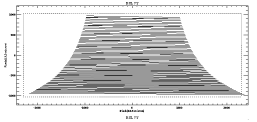 |
TRES
Observing Protocols
|

|
![[TDC Home]](/images/tdc-home.gif)
![[TDC Search]](/images/tdc-search.gif)
![[OIR Home]](/images/oir-home.gif)
|
[Definitions] [Preparation] [Observing Protocols] [Quicklook)] [Quick Pipeline)] [Full Pipeline)] [Reduction Software[ [Software Packages] [Distribution] [Archiving]
 |
TRES
Observing Protocols
|

|
![[TDC Home]](/images/tdc-home.gif)
![[TDC Search]](/images/tdc-search.gif)
![[OIR Home]](/images/oir-home.gif)
|
[Definitions] [Preparation] [Observing Protocols] [Quicklook)] [Quick Pipeline)] [Full Pipeline)] [Reduction Software[ [Software Packages] [Distribution] [Archiving]
Process the flat field files for each configuration using
ftres FLATx.list sumspec+ makeref+ interact+Rwhich will use a sum of the particle-hit-filtered flat field files to make both an extraction template and a apflattening image file.
Process the initial ThAr files for each configuration using
ttres COMPx.list compstd="sum" compid=yeswhich will remove particle hits from all of the listed ThAr files, extract them, and try to identify the emission lines based on the reference file compx.ec.fits in the ttres.compdir directory, where x is the configuration (m|l|s[b][1|2|3). The program will stop with a display of marked lines. Cross-correlate them using the "x" key, and refit using "f". The resulting residuals should less than 0.03. Delete outliers using "d" and refit using "f" until you get them down. Type "q" to quite fit mode, then "q" to quit the program and respond to the save query with "y" or carriage return to save the resulting dispersion function. The program will proceed to the second fiber, if one is present, and you should repeat the above activity.
At least three exposures (with similar exposure times) of each object should be taken to allow removal of particle hits which look like cosmic rays in the images. The shift in dispersion should be small enough that the COMP exposures taken through the night can all be combined to remove particle hits.
FLAT exposures should be taken through the night and at the end. They will be combined by the pipeline to remove particle hits, and summed to set the mask for extraction, so multiple FLATs taken through the night should capture any image drift.